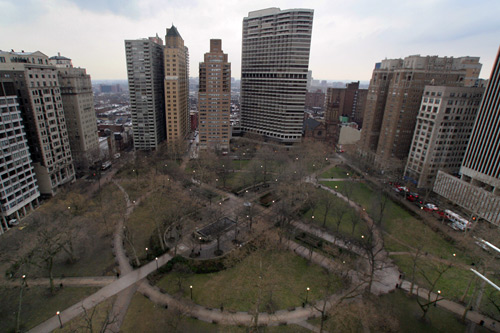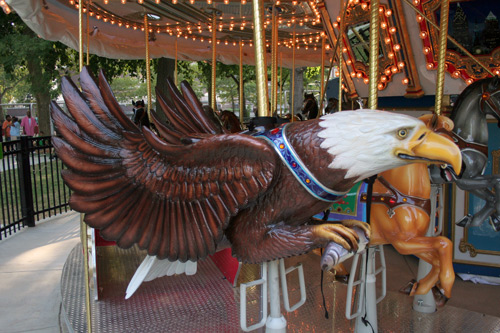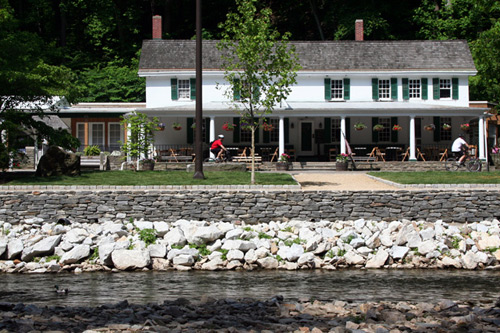by Nathaniel Popkin

I'll proceed, as did our Godmother Jane Jacobs, right into the physics of the squares.
We'll all agree that Rittenhouse, Jacobs' "success," is the most wonderful place in the world. Why? Well we know why: it's our stage, our promenade,
always
open and open to all. It is the only place in Philadelphia where – without restraint or self-consciousness – we embrace the idea and
fulfill the
act of living in public.
This is a curious thing to say about a city – even the so-called Private City, isn't it?
Why else live in a city but to live in public?
Public space abounds in Philadelphia. The sidewalk, of course, is the greatest of all. But ours are narrow, practical, and seem always at the mercy
of cars.
(The curb-cut mercilessly threatens even this fragile yet demarcated territory of the pedestrian.) Aside from a few notable exceptions, our sidewalks
are
famously boring. Yesterday on Walnut Street, I saw an elderly immigrant wearing an American flag baseball hat emblazoned with a gold eagle playing the
accordion. That, despite the joy of people in motion, was the extent of the entertainment.
My alter-ego Siskind says that Septa is really our most-trampled public space (at 300 million rides a year it may be true – it may also, despite
the
shooting on the 33 a couple of weeks ago, be our safest). And he's right: the average bus is more crowded than the average sidewalk. He's on to
something
more. Unlike in most cities, where people read, Philadelphians on the bus or the El talk to each other. I could write a book just from the
conversations I've heard/had on Septa. So, like it or not, stuffed like a sardine or not, on Septa we get to know each other – at least in
passing.
Septa, reflecting our vernacular urbanism, gives us an intimate public experience. But it lacks the scale, joy, and ambition of true urban space. And
so
here's our problem: we've public space aplenty, acres of dazzling potential, and almost nothing to do.
There are reasons: intimacy of scale, parochial ambition, Quaker influence, a reasonable desire for peace and quiet, fear/the desire to control, a
penchant for
missed opportunities, and a fetish for purity (the Magnolia Garden, the Azalea Garden, the Rose Garden), an addiction to symbolism. Thus, stepping
back into
the Squares, we can see how our potential becomes limited. While the uses and users of Washington Square are slowly becoming more dynamic, it remains
essentially a passive vessel of monuments. It is hallowed ground, but even the fountain is uninteresting. The buildings that frame the square, aside
from the
eponymous Starr restaurant, are closed to it. The subway station and associated scale (of Strawbridge and Clothier, of Lit Brothers) is three blocks
away.
There's no ice cream man, no balloons, music, or newspaper stand. Washington Square is a great place to nap.
The new Franklin Square, Skid Row Park in 1961 when Jacobs wrote "The uses of neighborhood parks" until 2005, is equally one-dimensional. (I'll stop
right
here and say that the upgraded Franklin Square, as the cliff-park along the Waterworks, the Schuylkill Banks Seine path, Laurie Olin's INHP
reconfiguration,
the ongoing reclamation of Logan Square (the Aviator Park part now being completed) are essential statements of belief in Philadelphia. They make us
happy.)
But Franklin Square, which does offer ice-cream, balloons, horses, and a lovely fountain is a caricature of the traditional city park. It functions
outside
the fabric of everyday city life: to get there, you have to plan in advance. And when you arrive, you feel you're nowhere. Nothing faces it but
Noguchi's
Lightning Bolt and the Benjamin Franklin Bridge. The over-sized colonial lamps appear as Manute Bol loping down the Spectrum floor, the carousel,
which my
kids adore, an amalgamation of styles, the mini-golf a half-assed city in miniature. The vendors and their extension cords both too formal and not
formal
enough . . .

But I'm being too harsh on Franklin Square. After all, the folks at Once Upon a Nation have broken that old brick wall between the purity of leisure
and the
filth of commerce.
Now we just have to break free of the heavy symbolism. Think about it: from the eternal flame in Washington Square to the Sister Cities plaza on Logan
Square,
our public spaces are pushed to the limit of representation and remembrance. INHP was redesigned on a symbolic balance beam between Independence Hall
and the
Constitution Center. That curious and beautiful sculpture garden on Kelly Drive? The Ellen Phillips Samuel Memorial was a modernist project on the
universal
experience of building the nation. The Benjamin Franklin Parkway and the Swann Fountain in particular: a generous tip of the hat to Paris and European
ideas
of urbanism. We call it our Champs Elysee: I say then where, at the very least, are the cafes? Why is Peacock on the Parkway my only option? The
flags of
the nations (which represent a terrific instinct) – it's all surface symbolism, not the reality of a true world city. Ed Bacon's compass in City
Hall
Courtyard? The City of Firsts displays on Penn's Landing. The war memorials, the Irish memorial, the Columbus Memorial, the International Sculpture
Garden,
Foglietta Plaza, the piazza in front of the Art Museum (oh, I could go on with these examples): empty all of them, burdened by being too pure, too
fetishized,
too in-love with the ideas and not the reality of urban life.
I'm beginning to sound like a pro-Barnes-move charlatan (I am in favor of the move). I'm in love as the next guy with symbolism, especially when it
encourages
you to think, explore, and imagine. So I think Venturi's Franklin House is pretty neat. And I bet I'm going to like the new President's House too.
But I'm
guessing the purists are reeling (they probably hate Franklin Court, anyway). They've stopped reading. We don't want to be New York! We don't
need
tourist shops everywhere. We won't give in to that low instinct to turn everything into a commodity . . . Greene Country Towne! Greene Country
Towne!
Greene Country Towne!
The funny thing is that it's those old-liners at the Pennsylvania Horticultural Society who, handing the charge over neighborhood parks back to the
neighbors,
began the movement to challenge the ruling paradigm. It turns out we folks like to use our parks: to play, to listen to music, for festivals, movies,
ceremonies, to eat, stroll, fight, to dig in the dirt. And so with the Horticultural Society's funding, neighbors across the city have taken control
of the
public spaces; and the Recreation Department provides funding and equipment and staff for concerts and films. The result is that many neighborhood
public
spaces are alive, as perhaps never before.
So what of the major venues? I think there are tendencies in the right direction. As much as I was opposed to it at first, placing the Please Touch
Museum in
Memorial Hall and making clear physical connections between it, the Zoo, PMA, the Mann, Japanese House, among other attractions and Martin Luther King
(West
River) Drive, might allow Fairmount Park to be enjoyed in new ways by more people. Indeed, turning the old Visitor's Center into a FP gateway is great
idea
too. We all need help finding the treasures. The Parkway plan is excellent; Penn Praxis' work on the Delaware may also reveal potential ways to
variegate the
experience. It's happening on the Schuylkill Banks, where apparently they get it. I'd like to see a restaurant or two down there, just as I proposed
for City
Hall Courtyard and Centre Square. I'd like to see more and more constant performance, ice cream, book stalls (The greatest outdoor book stalls maybe
in the
world are in Istanbul in the University section, so I propose turning the Chestnut Street edge of Penn's Hill field, space that essentially connects
Penn and
Drexel, into a permanent used book mart.), art, music, vendors, food stalls, stores, coffee, and tables. Headhouse Square is a New York-style
Washington
Square waiting to happen (the old Jewish anarchists used to meet right around the corner). The Merchant's Exchange, recently and dreadfully castrated
by the
Park Service, ought to present theatre and music from Back Then. Old Dock Street might fill again.

Just as I started with Rittenhouse, for similar reasons I'll end with Valley Green. Why do we love to go there? Yes, the Creek, the trees, the ducks.
That
isn't enough, though. We go there because we sit on the grass watching kids ride their bikes into the water; or on the porch of the Inn drinking beer.
We can
buy popcorn, walk, bike, ride horses. We can watch everyone else doing all these other things. We love it because it feels, in a strange way as only
Rittenhouse feels, as an open public space, a truly dynamic crossroads. It's powerful, moving, fun.
Now imagine so much more of Philly that way.
It might feel good to be impure.
–Nathaniel Popkin
nathaniel.popkin@gmail.com
|